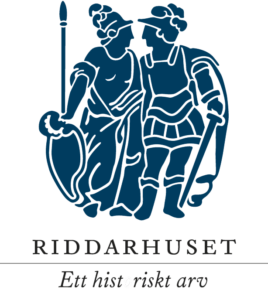History of the Swedish nobility
The Swedish nobility (Adeln), dates back to 1280, and the king Magnus Ladulås. It was agreed that magnates who could afford to contribute to the cavalry with a horse-soldier were to be exempted from tax. The Swedish term for nobility, frälse, includes also the clergy while referring to their exemption from tax.
Due to the many wars, the crown needed a means to reward officers, and since cash was not plentiful, ennoblement and grants of land were used instead. During the 17th century, the number of the noble families grew by a factor of five. In less than a century, the nobility”s share of Swedish land rose from 16% to over 60%, which led to considerably lower tax incomes.
The “reductions” of 1655 and 1680 however brought back land to the crown.
The Nobility was historically a privileged class in Sweden. Noble families and their descendants are still a part of Swedish society today, but do no longer retain any specific or granted privileges to speak of. The Swedish nobility is organized in to three classes according to a scheme introduced in 1561.
- Count (greve)
- Baron (friherre)
- Untitled nobility (obetitlad Adel).
Swedish dukes (hertig) have always been royals and counted as such.
The House of Knights
Following the elevation into nobility by the Swedish monarch, you could also “apply” to be introduced to the House of Knights (Riddarhuset), which formerly was a chamber in the Riksdag of the Estates, the Swedish Parliament. After 1866 the House of Knights served as an official representation on the nobility regulated by the Swedish government, but the regulation has decreased in step with the privileges. Most of the noble families are introduced and their members are listed in a calendar published every three years.
In contrast to the United Kingdom and the Benelux countries, no hereditary titles or honours have been granted since 1902, when explorer Sven Hedin was ennobled. After 1975 there is even no legal right of ennoblement.
The noble estate was never abolished in Sweden, but its privileged position has been weakened step by step since 1680. The nobility”s political privileges were practically abolished by the reformation of the Riksdag of the Estates in 1866, and the last rights of precedence to certain governmental offices were removed in the 1920s. By then also the last taxation privileges had been abolished. Some minor privileges remained up until 2003, when the law concerning the privileges of the nobility was completely abolished.
The privileges of the nobility today are limited to protection of noble titles and certain elements and styles used in coats of arms. Legal protection regarding names in Sweden does not make specific distinctions on the grounds of nobility.
Today the Nobility comprises 698 living families (out of aprox 2500), of whom 49 are of Count’s rank while 136 are Baronial and 513 aristocratic, with a total of some 27 000 members residing in Sweden and elsewhere.
 The Swedish House of Nobility: Riddarhuset
The Swedish House of Nobility: Riddarhuset
Objective
Riddarhuset is a palace and an organization for the noble families in Sweden. Its objective is to preserve, maintain, and protect a historical heritage.
History
The rise of the Swedish nobility dates from 1280, but the organization and official headquarters was established through Gustavus II Adolphus’ Riddarhus Decree from the year 1626. After the abolishment of the four estates in 1866 the organization of the nobility continued even though it no longer had any political role. Since 2003, the House of Nobility is completely disconnected from the State.
Organization
Every three years, representatives of the nobility assemble at Riddarhuset to review business transactions and activities. Each family (663 in total) has one vote. At this meeting, directors are elected for the forthcoming three-year period to be responsible for administering Riddarhuset’s activities.
Activities
- Organize the meeting of the nobility every three years
- Publish the Swedish Peerage Book every three years
- Keep the genealogical records up to date
- Manage over 330 funds, and distributes allowances and scholarships according to wills
- Manage five estates with substantial tracts of forest and farmland
- Manage an extensive archive and library, care of all documents
- Maintain the Palace
- Let the Palace for meeting and parties
- Offer an ambitious and substantial cultural program, open to the public
- Offer guided tours of the Palace, which is also open to the public every weekday
- Represent the Swedish nobility in CILANE
Publications
- Arte et Marte, member magazine, twice a year
- The Swedish Peerage Book, every three years
- Riddarhuset (the House of Nobility), new edition
- Riddarhusets vapenplåtar (2019) – a reference book in three volumes about the collection of over 2 300 coat of arms in Riddarhusets Great Hall
- Äldre svenska frälsesläkter, ÄSF
RAUK (Youth Club)
Ridderskapet och Adelns Ungdomsklubb (RAUK), a social club for members of the noble families between the ages of 18-35, was founded in 1989. The Idea was to help with the upbringing and education of the Noble youth, and to keep tradition and history alive to future generations. When we became members of CILANE, RAUK also started working to bring its members closer to the other organisations all over Europe.
There are now aprox 400 registered members and there is no annual fee. All those who are between 18-35, and members of the House of Nobility can apply.
There is an International Weekend organised every two years in Stockholm. And different activities for the members, such as opera, dance training, balls and other social events to bring the youth together.
Riddarhussällskapet (social club)
Riddarhussällskapet is a social club for members of the noble families.
Svenska Adelsförbundet
Svenska Adelsförbundet is an association for aiding noble family members that are in need, mainly the elderly and ill. Svenska Adelsförbundet is the contact part for the Swedish participation in the CILANE youth exchange program.